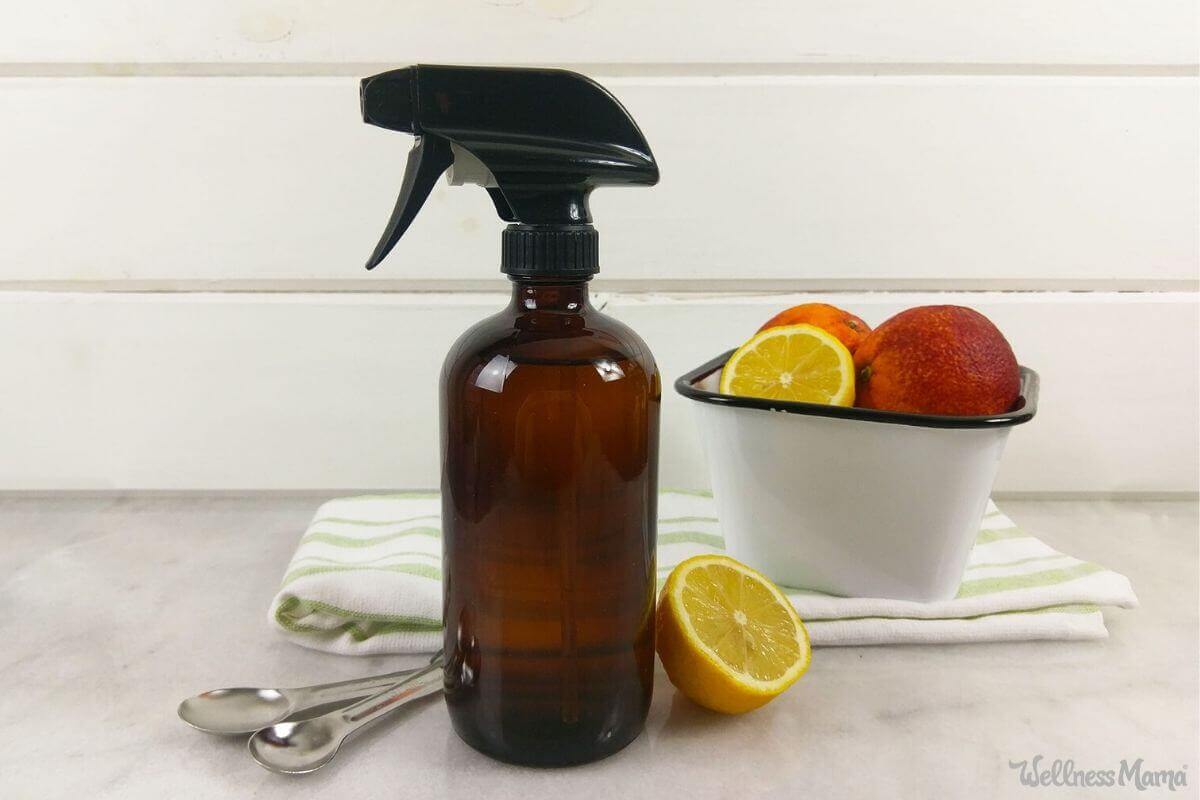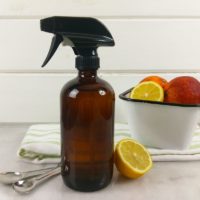I’m not big on sanitizing everything all the time, but some situations call for the big guns. This spray is like my homemade disinfecting wipes, but with a longer shelf life. It’s convenient, quick, and combines powerful essential oils with proven recommended disinfectants like hydrogen peroxide or alcohol.
I based this recipe on careful research from the CDC, EPA, Stanford University, and other sources, but of course I cannot make any claims as to its effectiveness on certain viruses or bacteria. This is just a formula that I personally feel comfortable using around my house when I need it. As with everything, I encourage you to do your own research and make sure any product you use meets your own needs and criteria right now.
Why Use Homemade Disinfectant Spray?
If you’ve read my other posts, you know that I don’t use antibacterial cleaners unless I absolutely have to (which isn’t often). I do buy certain pre-made natural soaps and detergent, but I also enjoy keeping things simple and mixing up what I need from a few simple staples in my pantry or cleaning closet.
Homemade DIY cleaning recipes also help avoid harsh chemicals because you know exactly what’s going into the formula. According to the American Lung Association, many chemical-laden disinfectant products are linked with asthma, respiratory problems, headaches, and more. Also some people can’t tolerate cleaners with fragrances and other ingredients, or simply want a more natural alternative.
Since I don’t use disinfectants very often, I came up with this disinfectant spray from ingredients and essential oils I already had on hand. It saves a trip to the store or storing another bottle in my cleaning closet.
Does It Really Work Though?
There are a thousand and one cleaning products recipes floating around on the Internet. So how can we know a homemade cleaner actually works and we’re not just getting peppermint-scented, salmonella-covered countertops?
Cleaners at the store are tested to make sure they do what they say they do and are effective. That’s definitely not the case with a homemade formula. However, we do know a lot about effective natural disinfectants from published research. Some natural ingredients are even on CDC-approved lists, with specific guidance about how much and how to use them.
Please, as always, do your own research (I’ve offered links below to mine) and seek your doctor’s advice for the best approach for your family.
Germ-Fighting Essential Oils
Essential oils are amazing little things that can pack a powerful punch. One reason why it’s so important to use them safely! It isn’t enough to say an essential oil is antibacterial or antiviral though and leave it at that.
Certain essential oils are effective against certain pathogens, but not others. For example, a 2020 article in Biomolecules reports clove essential oil works well against salmonella and E. coli bacteria. However, clove doesn’t have any effect on certain pneumonia-causing bacteria.
How Natural Disinfecting Works
Viruses work differently than bacteria because they hijack healthy cells and replicate. Some viruses also have a coating surrounding them, called a viral envelope. If we don’t use the right antiviral, it can’t break down the outside coating and inactivate the virus.
Here are some germ-fighting essential oils and how they work:
- Oregano essential oil – antiviral, antifungal, antimicrobial. Also disrupts the viral envelope according to this study.
- Clove essential oil – antiviral, antifungal, antibacterial and disrupts the viral envelope
- Thyme essential oil (thymol chemotype) – kills some viruses and at the time of this post, a product containing thymol is on the list of EPA-approved disinfectants for SARs-related viruses.
- Tea tree essential oil – antiviral against flu viruses, including H1N1. Antibacterial, including MRSA and other pathogens.
- Orange essential oil – broad spectrum antiviral, antibacterial, antifungal
- Red mandarin essential oil – antibacterial and antifungal
- Lemon essential oil – antibacterial and antifungal
Keeping It Happy
Citrus oils like orange, lime, lemon, bergamot, and grapefruit can uplift the mood. Killing harmful pathogens while we reduce stress and anxiety? Score.
What Are the Best Natural Disinfectants?
Natural disinfectants do exist. Here are some of the options I’ve personally researched and used:
Alcohol
This is one of the most popular disinfectants used for hand sanitizers and hard surfaces. Many homemade products don’t have enough alcohol to work well though. According to the CDC 60-90% alcohol is necessary to make a disinfectant that works. (The reason I updated my hand sanitizer recipe.)
If we start off with 60% alcohol and then dilute it with water… we just killed the efficacy of the cleaner.
What About Vodka?
The average vodka is 80 proof, or 40 percent alcohol. Even if we use it straight up that’s well below the recommended 60 percent. If you opt for vodka it needs to be at least 120 proof.
Isopropyl Alcohol (Rubbing Alcohol)
Rubbing alcohol is available at pharmacies and most grocery stores. It’s cheaper than vodka and ranges from about 70-90% alcohol so it fits the bill for a homemade disinfectant spray.
Note: Sensitive noses may have trouble with the fumes from an alcohol-based spray. If this is you, opt for hydrogen peroxide instead.
Hydrogen Peroxide
This unassuming cleaner is hiding out in bathroom cabinets across the nation. Unlike alcohol, we only need a small amount of hydrogen peroxide to disinfect. Commercial preparations use .5 -1% total hydrogen peroxide, compared to 60-90% alcohol.
Peroxide attacks pathogens and is one of the few natural EPA-approved disinfectants. This cleaner also works against rhinoviruses, flu, and viruses that cause the common cold. A 1977 article, “Virus Inactivation by Hydrogen Peroxide,” reports it inactivates the viruses and stops them in their tracks.
There’s a catch though… according this article, hydrogen peroxide may not disinfect properly if the area has dirt and dust on it:
If it (hydrogen peroxide) comes into contact with other molecules like organics and soil that haven’t been cleaned before the disinfectant was sprayed, then effectiveness will degrade. Processes that include thorough cleaning before the disinfectant application will need to be a high priority when using hydrogen peroxide disinfectants.
Yes, it’s annoying to clean a surface twice (once for dirt and second for microbes), but that’s how this cleaner works best. Some disinfectants take up to 30 minutes to work, but peroxide can destroy germs in just one minute.
Thymol
Another EPA-approved natural disinfectant is thymol. Found in high amounts in thyme essential oil, this compound kills both viruses and bacteria. Approved commercial cleaners use a .05% concentration of thymol. That doesn’t mean we can just use .05% thyme oil though, since the thymol content varies.
Some thyme oil brands have as little as 26% thymol, while others can have 50% or more. That’s a huge difference when we’re figuring for only .05 percent! Plant Therapy is one of my favorite essential oil brands and they release the GCMS test reports of all their oils. This makes it easy to know exactly how much thymol is in their essential oil.
According to the EPA, wait 10 minutes before wiping thymol-based cleaners off of surfaces.
Important Note on Essential Oil Choice:
I’ve given several options for how to make this cleaner so you can use what you have on hand. Pick a base (hydrogen peroxide OR alcohol), and choose from the suggested essential oils.
Note: On average, Plant Therapy thyme oil has about 40% thymol. This means we need to use .58 ml or about 12 drops per 16 ounces of cleaning solution to hit that .05% concentration. It’s best to get the thyme thymol chemotype, but thyme linalool can also work. Since the linalool variety has much less thymol you’ll need to triple the amount used in the recipe.
Homemade Disinfectant Spray Recipe
Equipment
Materials
Choose one of the following essential oil options:
- 12-36 drops thyme essential oil see note about chemotypes
- 1 scant tsp orange essential oil OR lemon essential oil
- ½ tsp clove essential oil
- 1 scant tsp tea tree essential oil
- ½ tsp cinnamon essential oil
For alcohol based recipe:
- 16 oz 120 proof vodka or rubbing alcohol
For hydrogen peroxide based recipe:
- ⅓ cup + 1 tsp 3% hydrogen peroxide
- 13 oz distilled water
Instructions
- In a 16-ounce glass spray bottle, add the desired essential oils.
- Add the alcohol OR the hydrogen peroxide and distilled water. Regular tap water will quickly grow bacteria.
- Close the top and lightly shake to mix.
Notes
This article was medically reviewed by Dr. Scott Soerries, MD, Family Physician and Medical Director of SteadyMD. As always, this is not personal medical advice and we recommend that you talk with your doctor.
Do you use a natural disinfecting method? Which brands or recipes do you like best?





Leave a Reply